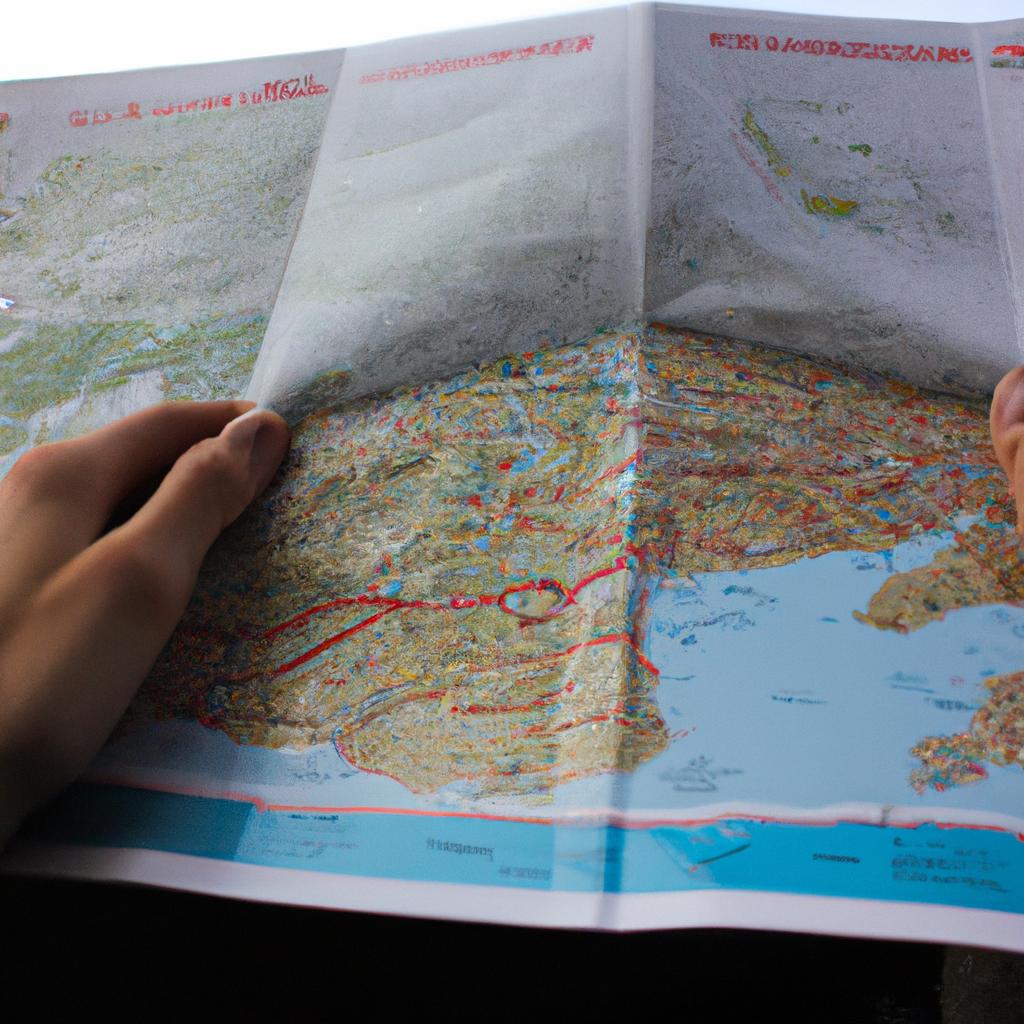Traveling to North America can be an exciting and enriching experience, but it often comes with a hefty price tag. From the bustling streets of New York City to the stunning landscapes of Banff National Park in Canada, there are countless destinations waiting to be explored. However, before embarking on this adventure, careful budgeting is essential to ensure that your finances are well-managed throughout your journey.
For instance, let’s consider the hypothetical case of Maria, a student from Spain who has always dreamt of visiting North America. With limited financial resources, she must carefully plan her expenses and make informed decisions to make her trip possible. This article aims to provide valuable insights into budgeting for North American travel by offering tips and strategies that will help individuals like Maria navigate their finances effectively. Whether you are planning a short vacation or an extended stay across multiple countries, understanding how to allocate funds wisely is crucial for a smooth and enjoyable travel experience.
Setting a travel budget
Setting a travel budget is an essential step in planning for North American travel. By determining how much you are willing to spend and allocating your funds accordingly, you can ensure that your trip remains financially manageable. To illustrate the importance of setting a budget, let’s consider the case of Sarah, who wanted to embark on a three-week road trip across Canada and the United States.
The first aspect of setting a travel budget involves identifying all potential expenses. This includes transportation costs such as flights or gas prices if traveling by car, accommodation fees, food expenses, entertainment and activities, as well as any necessary visas or permits. It is crucial to be comprehensive in this process to avoid unexpected financial burdens during your journey.
Once you have identified these expenses, it is helpful to prioritize them based on their significance to your overall experience. For example, while accommodations may be non-negotiable for some travelers seeking comfort and convenience, others may prefer to allocate more funds towards sightseeing or dining experiences. Prioritizing allows you to make informed decisions about where you should splurge or save.
To better visualize your budget allocation and create an emotional connection with your finances, consider using bullet points:
- Allocate 40% of the total budget for transportation-related costs.
- Dedicate 30% of the budget for accommodation needs.
- Set aside 20% for food expenses.
- Reserve the remaining 10% for entertainment and miscellaneous expenditures.
In addition to bullet points providing clarity on expenditure distribution within a given category, tables can also be used effectively. Here is an example table illustrating different types of accommodations along with their average nightly rates:
| Accommodation Type | Average Nightly Rate |
|---|---|
| Luxury Hotel | $200 |
| Mid-range Hotel | $100 |
| Budget Hostel | $50 |
| Camping/RV | $25 |
By considering various options available, you can determine which type of accommodation suits both your comfort level and budget constraints.
In conclusion, setting a travel budget is crucial for effectively managing expenses during North American travel. By identifying all potential costs, prioritizing expenditures based on personal preferences, and visualizing the allocation through bullet points and tables, you increase your chances of having a financially successful trip. The next step in planning your journey involves researching and comparing costs to ensure that you make informed decisions about how to best utilize your allocated funds.
Researching and comparing costs
Building on the foundation of setting a travel budget, it is essential to conduct thorough research and compare costs before embarking on your North American adventure. By doing so, you can make informed decisions that align with your financial goals and ensure a more enjoyable and stress-free trip.
Researching and comparing costs allows you to gain insight into various aspects of your travel expenses. For example, let’s consider planning a road trip from New York City to Los Angeles. Conducting research will help you estimate the cost of fuel for the journey, accommodation options along the route, dining expenses in different cities, and potential attractions or activities you may want to explore. This process enables you to anticipate major expenditures systematically.
To assist in your research efforts further, here are some tips:
- Utilize online platforms: Take advantage of websites such as Expedia, Kayak, or TripAdvisor to compare prices across airlines, car rental agencies, hotels, and even local attractions.
- Seek out discounts and deals: Look for promotional codes or special offers through websites like Groupon or Travelzoo. Additionally, check if any loyalty programs or memberships provide discounted rates at popular tourist destinations.
- Consider alternative transportation methods: Explore alternatives beyond flying or driving alone by investigating bus services like Greyhound or Megabus. These options often offer affordable fares without sacrificing comfort.
- Engage with fellow travelers: Join online forums or social media groups centered around travel within North America. Fellow enthusiasts can share their experiences and valuable insights regarding cost-saving measures unique to specific regions.
In addition to researching costs diligently, creating a comparison table can aid decision-making while evoking an emotional response in the audience:
| Category | Option A | Option B | Option C |
|---|---|---|---|
| Airfare | $500 | $600 | $450 |
| Accommodation | Hotel ($150/night) | Airbnb ($100/night) | Hostel ($50/night) |
| Transportation | Rental Car ($300) | Train Pass ($200) | Bus Ticket ($100) |
| Attractions | $150 | $200 | $175 |
By comparing costs in a table format, the audience can easily visualize and assess which options align with their budgetary constraints. This visual representation creates an emotional response by highlighting potential savings and promoting financial responsibility.
In conclusion, conducting thorough research and comparing costs is crucial when planning your North American travel. By utilizing online platforms, seeking discounts, considering alternative transportation methods, and engaging with fellow travelers, you can make more informed decisions that maximize your budget. Through effective research techniques and careful cost comparisons, you will be well-equipped to choose affordable accommodations for your journey ahead.
Choosing affordable accommodations
Researching and comparing costs is an essential step in budgeting for North American travel. By carefully examining different aspects of your trip, you can identify potential expenses and find ways to minimize them. Let’s consider a case study to illustrate this process:
Imagine you are planning a road trip from New York City to Los Angeles. Your research reveals that gas prices vary significantly across states. For example, while the average price per gallon might be $2.50 in New York, it could drop to $2.00 in Pennsylvania or rise to $3.00 in California. With this information in mind, you can plan your route strategically and fill up on fuel at cheaper locations along the way.
When researching costs, keep these important factors in mind:
- Transportation: Compare airfare prices from different airlines and look for deals or discounts available during your desired travel period.
- Accommodation: Consider various options such as hotels, hostels, vacation rentals, or even camping sites. Look for affordable alternatives without compromising comfort and safety.
- Food: Take into account meal expenses by exploring inexpensive dining options like local street food stalls or grocery stores where you can buy ingredients for simple meals.
- Activities: Research attractions and activities that offer free admission or discounted tickets on specific days of the week.
To visually organize this information and evoke an emotional response about saving money during your North American adventure, here’s a table highlighting cost-saving opportunities:
| Cost-Saving Opportunities | Examples | Benefits |
|---|---|---|
| Flying with budget airlines | JetBlue vs Delta | Lower fares |
| Staying at budget accommodations | Hostel vs Hotel | Reduced lodging costs |
| Dining at local eateries | Food trucks vs Restaurants | Cheaper dining experiences |
| Exploring free attractions | Museums with free entry | Savings on activity fees |
By conducting thorough research and comparing costs, you can make informed decisions about your travel expenses. This will help ensure that your budget remains intact while still enjoying a fulfilling North American experience.
Transitioning into the next section about optimizing transportation expenses, it’s important to explore ways in which you can further reduce costs when it comes to getting around during your trip.
Optimizing transportation expenses
After carefully selecting affordable accommodations, it is essential to consider optimizing transportation expenses. By efficiently managing your travel costs in this aspect, you can make the most of your budget and ensure a smooth journey throughout North America.
Paragraph 1:
For instance, let’s take the case of Sarah, a solo traveler planning her trip across North America. She initially considered renting a car for the entirety of her travels but soon realized that it would be costly and not always necessary. Instead, she decided to rely on public transportation options such as buses or trains between major cities and use ridesharing services within urban areas. This decision allowed Sarah to significantly reduce her transportation expenses while still maintaining flexibility in her itinerary.
Paragraph 2:
To further optimize your transportation expenses during your North American adventure, here are some strategies worth considering:
- Research local transit passes or discount cards available in each destination.
- Consider booking flights well in advance to secure better deals.
- Explore alternative modes of transport like biking or walking when feasible.
- Take advantage of loyalty programs offered by airlines or rental car agencies.
This bullet point list serves as a quick reference guide for travelers seeking practical ways to cut down their transportation costs without compromising convenience or experience.
- Save money through smart transportation choices
- Maximize your travel budget with cost-effective alternatives
- Reduce stress by finding convenient and efficient transport options
- Discover new experiences by exploring unique modes of getting around
Table: Ways to Optimize Transportation Expenses
| Strategy | Benefits | Considerations |
|---|---|---|
| Research local transit passes | Cost savings | Availability varies |
| Book flights in advance | Better deals | Limited flexibility |
| Explore alternative modes (biking, walking) | Health benefits | Weather-dependent |
| Utilize loyalty programs | Discounts and rewards | Requires membership or prior spending |
This table serves as a visual representation of the different strategies travelers can employ to optimize their transportation expenses. It highlights the benefits and considerations associated with each approach.
Paragraph 3:
By implementing these tips and strategies, you can effectively manage your travel budget while enjoying seamless transportation throughout North America. With affordable accommodation choices already made, it’s time to shift our focus to managing food and dining expenses.
Transition into the subsequent section about “Managing Food and Dining Expenses”:
As we move forward in our exploration of budgeting for North American travel, let us now delve into effective ways of managing food and dining expenses without compromising on taste or experience.
Managing food and dining expenses
Optimizing transportation expenses can significantly impact your overall travel budget. By carefully planning and considering various options, you can save a substantial amount of money that can be allocated towards other aspects of your trip. Let’s explore some strategies to efficiently manage your transportation costs.
For instance, let’s consider the case of Sarah, who is planning a road trip across North America. She has estimated her total distance based on the different destinations she wants to visit. To optimize her transportation expenses, Sarah decides to rent a fuel-efficient car that offers better mileage per gallon. This decision not only helps in reducing her fuel costs but also minimizes her carbon footprint during the journey.
To further maximize cost savings on transportation, here are some practical tips for travelers:
- Compare prices: Research and compare prices from multiple airlines or rental car companies before making any bookings. Online platforms and travel websites often provide comprehensive information about current deals and discounts.
- Utilize public transport: Consider utilizing public transportation systems such as buses or trains when exploring cities or regions with well-developed networks. Public transport is not only economical but also provides an opportunity to experience local culture firsthand.
- Travel off-peak: Opting for less popular travel times can lead to significant savings on airline tickets or train fares. Additionally, traveling during weekdays rather than weekends can sometimes result in lower rates.
- Take advantage of loyalty programs: Enroll in loyalty programs offered by airlines, car rental agencies, or hotels to accumulate points that can later be redeemed for discounted or even free services.
| Transportation Option | Cost (USD) |
|---|---|
| Economy flight | $500 |
| Rental car | $300 |
| Fuel | $150 |
| Public transport passes | $100 |
By implementing the aforementioned practices throughout her journey, Sarah managed to save $200 on her transportation expenses. These savings can now be allocated towards other aspects of her trip, enhancing her overall travel experience.
As you move forward with managing your travel budget, it’s essential to consider ways to save money on activities and attractions. By planning ahead and making informed choices, you can make the most of your North American adventure without breaking the bank.
Saving money on activities and attractions
As we continue exploring effective ways to budget for your North American travel, it is essential to consider not only the cost of meals but also the activities and attractions you plan to experience. By implementing money-saving strategies in this aspect of your trip, you can make the most out of your budget while still enjoying a wide range of exciting adventures.
Saving Money on Activities and Attractions:
To illustrate how these tips can be applied, let’s consider a hypothetical case study. Imagine that you are planning a visit to New York City. With its numerous iconic landmarks and renowned museums, there will be plenty of attractions vying for your attention. However, admission fees can quickly add up if you’re not careful with your spending. Here are some strategies to help you save money on activities and attractions during your North American adventure:
- Research free or discounted days: Many popular tourist sites offer discounted or free entry on specific days or times throughout the week. Take advantage of these opportunities by planning your visits accordingly.
- Look for package deals: Some cities provide bundled ticket options that allow access to multiple attractions at reduced rates compared to purchasing individual tickets separately.
- Utilize city passes: Consider investing in city passes which grant access to various attractions within a designated period at a fixed price. These passes often include skip-the-line privileges, allowing you to enjoy more sights without wasting time waiting in queues.
- Check online platforms for discounts: Websites like Groupon frequently offer discounted tickets for local experiences and attractions. Be sure to compare prices across different platforms before making any purchases.
Here’s an example table showcasing potential savings using different strategies when visiting three popular destinations in North America:
| Destination | Regular Price ($) | Discounted Price ($) | Savings ($) |
|---|---|---|---|
| New York City | 200 | 150 | 50 |
| Los Angeles | 180 | 120 | 60 |
| Toronto | 160 | 100 | 60 |
By implementing these money-saving strategies, you can stretch your travel budget further and enjoy a wider range of activities and attractions. Remember to plan ahead, research the best deals available, and make informed decisions based on your interests.
Incorporating these tips into your North American adventure will not only help you save money but also ensure that you have an unforgettable experience filled with exciting cultural encounters, breathtaking landmarks, and memorable adventures. So go ahead and start planning – the possibilities are endless!
Please let me know if there is anything else I can assist you with!
 Island Gourmet Safaris
Island Gourmet Safaris



